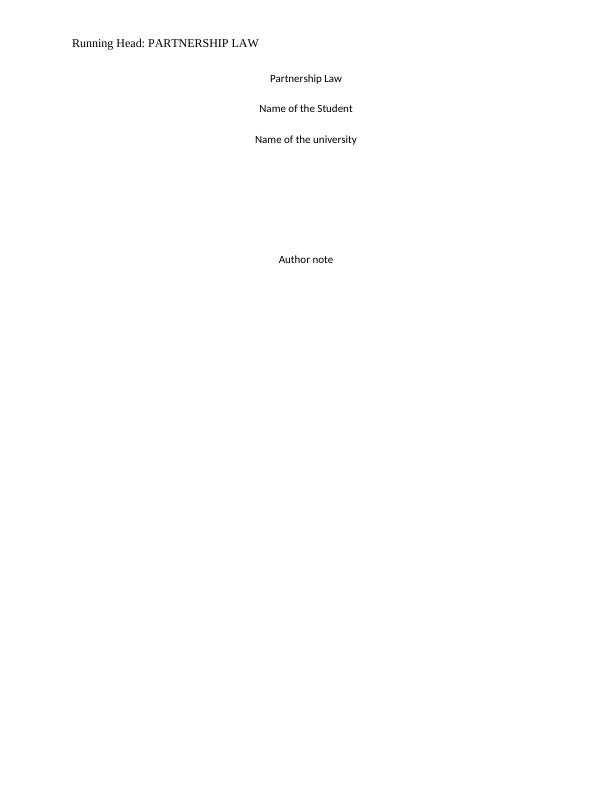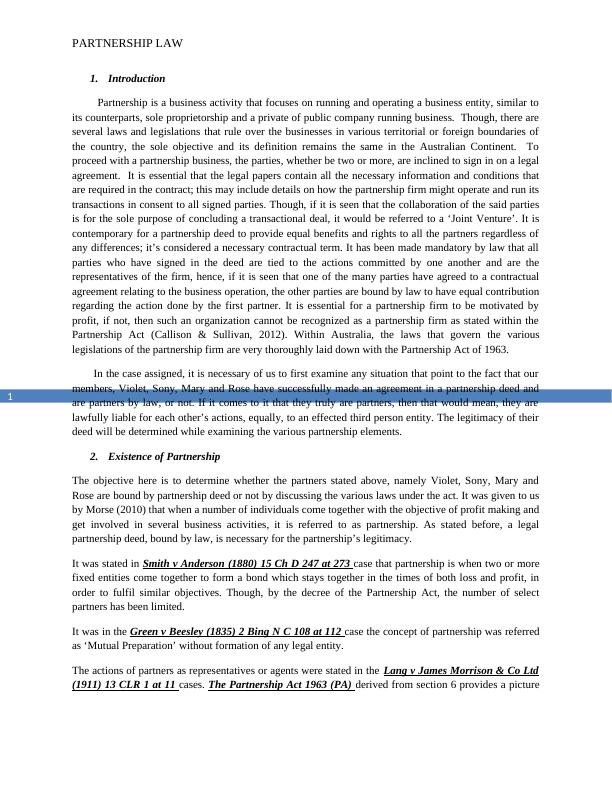Partnership Law | Assignment
Added on 2020-03-16
6 Pages2419 Words41 Views
Running Head: PARTNERSHIP LAWPartnership LawName of the StudentName of the universityAuthor note

1PARTNERSHIP LAW1.Introduction Partnership is a business activity that focuses on running and operating a business entity, similar toits counterparts, sole proprietorship and a private of public company running business. Though, there areseveral laws and legislations that rule over the businesses in various territorial or foreign boundaries ofthe country, the sole objective and its definition remains the same in the Australian Continent. Toproceed with a partnership business, the parties, whether be two or more, are inclined to sign in on a legalagreement. It is essential that the legal papers contain all the necessary information and conditions thatare required in the contract; this may include details on how the partnership firm might operate and run itstransactions in consent to all signed parties. Though, if it is seen that the collaboration of the said partiesis for the sole purpose of concluding a transactional deal, it would be referred to a ‘Joint Venture’. It iscontemporary for a partnership deed to provide equal benefits and rights to all the partners regardless ofany differences; it’s considered a necessary contractual term. It has been made mandatory by law that allparties who have signed in the deed are tied to the actions committed by one another and are therepresentatives of the firm, hence, if it is seen that one of the many parties have agreed to a contractualagreement relating to the business operation, the other parties are bound by law to have equal contributionregarding the action done by the first partner. It is essential for a partnership firm to be motivated byprofit, if not, then such an organization cannot be recognized as a partnership firm as stated within thePartnership Act (Callison & Sullivan, 2012). Within Australia, the laws that govern the variouslegislations of the partnership firm are very thoroughly laid down with the Partnership Act of 1963. In the case assigned, it is necessary of us to first examine any situation that point to the fact that ourmembers, Violet, Sony, Mary and Rose have successfully made an agreement in a partnership deed andare partners by law, or not. If it comes to it that they truly are partners, then that would mean, they arelawfully liable for each other’s actions, equally, to an effected third person entity. The legitimacy of theirdeed will be determined while examining the various partnership elements. 2.Existence of Partnership The objective here is to determine whether the partners stated above, namely Violet, Sony, Mary andRose are bound by partnership deed or not by discussing the various laws under the act. It was given to usby Morse (2010) that when a number of individuals come together with the objective of profit making andget involved in several business activities, it is referred to as partnership. As stated before, a legalpartnership deed, bound by law, is necessary for the partnership’s legitimacy. It was stated in Smith v Anderson (1880) 15 Ch D 247 at 273 case that partnership is when two or morefixed entities come together to form a bond which stays together in the times of both loss and profit, inorder to fulfil similar objectives. Though, by the decree of the Partnership Act, the number of selectpartners has been limited.It was in the Green v Beesley (1835) 2 Bing N C 108 at 112 case the concept of partnership was referredas ‘Mutual Preparation’ without formation of any legal entity.The actions of partners as representatives or agents were stated in the Lang v James Morrison & Co Ltd(1911) 13 CLR 1 at 11 cases. The Partnership Act 1963 (PA) derived from section 6 provides a picture

2PARTNERSHIP LAWof a partnership firm along with the profit making objective in an incorporated type of partnership. Anexternal type partnership is also defined in this section.2.1.Rose and MaryIt is provided to us that both Mary and Rose are involved in a business shop, that they named ‘Busy BeeFlorists’. That would mean that the couple had signed a deed which binds them to whatever action takenby one another in a business scenario. The business was suffering a loss due to the unpredicted droughtand extremely hot climate. The partners had had applied for a loan from a bank as per the provisions,which includes an equal distribution of both losses and profits. A third party, Violet was given a share inthe profit sharing by Rose in exchange for a loan, since the action was done with accordance to thepartnership, it is legal. Similarly, Mary, in exchange for loan, gave away another share of profit to anemployee named Sonny. After getting the credit, the old partners take vacation, informing the bank of theinclusion of Violet and Sonny in the firm, which was suffering heavy losses. The objective is to identifythe legitimacy of entry of new partners and their part regarding the bank credit. 2.2.Violet’s Legal PositionThe contractual terms that Violet was provided by Rose in exchange for a sum of $20000 as credit arestated in this section. Violet is assigned to 20% of profits which also includes the losses, empowering herwith the power to go through the business’s accounting statements. She has right to provide statements forbusiness in the firm at a quarterly basis. The final condition would be that the credit facilitated by herwould be considered a mere credit and she will not be included in the partnership deed. This documentwas signed before the credit was provided by Violet.The legitimacy of a partnership contract executed by the parties and their relation is judged by Section 7under Partnership Act. Sub-Section 2-4 of Section 7(1) exemplifies the various laws and provisions thatportray the relationship of such a partnership deed among the parties. Ruddock (1879) 5 VLR (IP & M) 51 case has made it very clear that even in situations where theagreement clearly states that the entity in question may not enter the partnership, if certain conditions arefulfilled, the entity will be entitled as partners contradicting the statement of the agreement. Theseconditions may also include the basic right of distribution of the profit sharing ratio. This shows thatwords of an agreement might be contradicted if conditions are fulfilled. Canny Gabriel Castle Advertising Pty Ltd & Anor v Volume Sales (Finance) Pty Ltd (1974) 131 CLR321 case was when the business agreement of the parties provided that their activities are solely asupposed joint venture but the court ruled otherwise. As per the law, it was seen that the deed was neithera loan agreement nor joint venture. In-fact, it was partnership deed as both the entities had the same goalof profit making, which was decided to be distributed equally. Cox v Hickman (1880) 8 HL Cas 268 andTelevision Broadcasters Ltd v Ashtons Nominees Pty Ltd (No1) (1979) 22 SASR 552 case discussed the provision in the Partnership act that bring clarity to thesituation where a profit sharing evidence, that is a receipt can be used to state the various relationships ina business firm, just variation in profit won’t solidify anything about the entities being in a partnershipcontract.

End of preview
Want to access all the pages? Upload your documents or become a member.
Related Documents
MA506/GA506 Business and Company Lawlg...
|7
|2364
|263
Corporation Lawlg...
|8
|2468
|78
Company Law Case Study : Assignmentlg...
|10
|2666
|48
Corporations Lawlg...
|8
|2556
|30
Corporate Law: Comparison of Partnership and Incorporationlg...
|13
|3941
|105
Business and Corporations Law Analysis Assignmentlg...
|11
|3280
|265
